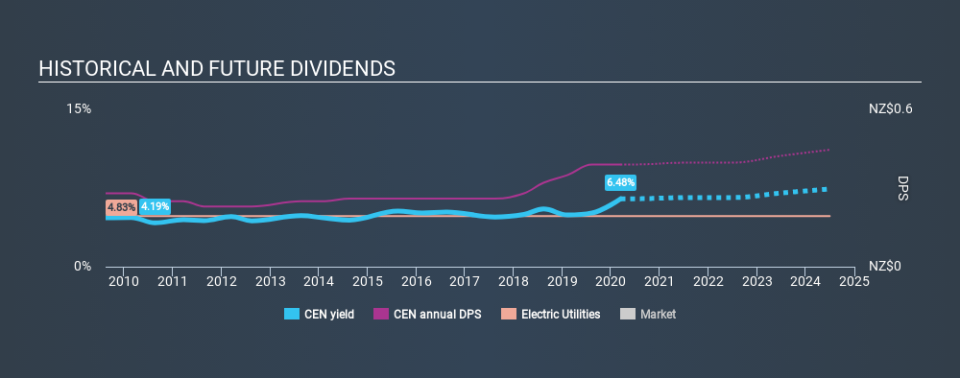It Might Be Better To Avoid Contact Energy Limited's (NZSE:CEN) Upcoming Dividend

Some investors rely on dividends for growing their wealth, and if you're one of those dividend sleuths, you might be intrigued to know that Contact Energy Limited (NZSE:CEN) is about to go ex-dividend in just 4 days. Ex-dividend means that investors that purchase the stock on or after the 18th of March will not receive this dividend, which will be paid on the 7th of April.
Contact Energy's next dividend payment will be NZ$0.18 per share, and in the last 12 months, the company paid a total of NZ$0.39 per share. Last year's total dividend payments show that Contact Energy has a trailing yield of 6.5% on the current share price of NZ$6.02. Dividends are a major contributor to investment returns for long term holders, but only if the dividend continues to be paid. As a result, readers should always check whether Contact Energy has been able to grow its dividends, or if the dividend might be cut.
Check out our latest analysis for Contact Energy
Dividends are usually paid out of company profits, so if a company pays out more than it earned then its dividend is usually at greater risk of being cut. An unusually high payout ratio of 214% of its profit suggests something is happening other than the usual distribution of profits to shareholders. A useful secondary check can be to evaluate whether Contact Energy generated enough free cash flow to afford its dividend. The company paid out 94% of its free cash flow over the last year, which we think is outside the ideal range for most businesses. Companies usually need cash more than they need earnings - expenses don't pay themselves - so it's not great to see it paying out so much of its cash flow.
As Contact Energy's dividend was not well covered by either earnings or cash flow, we would be concerned that this dividend could be at risk over the long term.
Click here to see the company's payout ratio, plus analyst estimates of its future dividends.
Have Earnings And Dividends Been Growing?
Companies with falling earnings are riskier for dividend shareholders. If earnings fall far enough, the company could be forced to cut its dividend. With that in mind, we're discomforted by Contact Energy's 11% per annum decline in earnings in the past five years. When earnings per share fall, the maximum amount of dividends that can be paid also falls.
Another key way to measure a company's dividend prospects is by measuring its historical rate of dividend growth. In the past ten years, Contact Energy has increased its dividend at approximately 3.4% a year on average. The only way to pay higher dividends when earnings are shrinking is either to pay out a larger percentage of profits, spend cash from the balance sheet, or borrow the money. Contact Energy is already paying out 214% of its profits, and with shrinking earnings we think it's unlikely that this dividend will grow quickly in the future.
To Sum It Up
From a dividend perspective, should investors buy or avoid Contact Energy? It's looking like an unattractive opportunity, with its earnings per share declining, while, paying out an uncomfortably high percentage of both its profits (214%) and cash flow as dividends. Unless there are grounds to believe a turnaround is imminent, this is one of the least attractive dividend stocks under this analysis. Overall it doesn't look like the most suitable dividend stock for a long-term buy and hold investor.
With that in mind though, if the poor dividend characteristics of Contact Energy don't faze you, it's worth being mindful of the risks involved with this business. Every company has risks, and we've spotted 3 warning signs for Contact Energy (of which 1 is significant!) you should know about.
We wouldn't recommend just buying the first dividend stock you see, though. Here's a list of interesting dividend stocks with a greater than 2% yield and an upcoming dividend.
If you spot an error that warrants correction, please contact the editor at editorial-team@simplywallst.com. This article by Simply Wall St is general in nature. It does not constitute a recommendation to buy or sell any stock, and does not take account of your objectives, or your financial situation. Simply Wall St has no position in the stocks mentioned.
We aim to bring you long-term focused research analysis driven by fundamental data. Note that our analysis may not factor in the latest price-sensitive company announcements or qualitative material. Thank you for reading.

 Yahoo Finance
Yahoo Finance 
